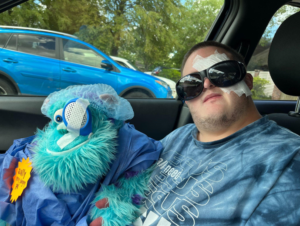
Children born with Down syndrome face many health issues, including vision disorders. In fact, research shows that an estimated 5-30% of people with Down syndrome are also affected by keratoconus[1][2], even though it is considered a rare disease. Christopher is one of those individuals who has Down syndrome and is also living with keratoconus.
At 26 years old, Christopher is unstoppable – he has participated in multiple triathlons, enjoys line dancing, hiking, swimming, bowling, watching Disney movies, and loves to read. While his vision issues have played a major role in his life, it wasn’t until recently that Christopher and his mother, Mary, learned about progressive keratoconus and the iLink® FDA-approved cross-linking procedure. As part of Down Syndrome Awareness Month, Mary and Christopher are hopeful Christopher’s keratoconus journey inspires other families who may be going through something similar.
Learning About Keratoconus
One morning while Christopher and Mary were out training for a triathlon, Mary realized Christopher could not read a street sign that was right in front of him. At this point, Christopher was already wearing eyeglasses due to astigmatism and had been diagnosed with cataracts. Mary’s motherly instincts kicked in and she made an appointment with Dr. Blake Williamson at Williamson Eye. During the appointment, Christopher was diagnosed with progressive keratoconus in both eyes. Dr. Williamson explained that keratoconus was prevalent in the Down syndrome community and discussed the available treatment options. It was then that he went into detail about cross-linking and how the iLink® procedure would be the right treatment for Christopher to help slow or halt the progression of his keratoconus and preserve his vision. Not wanting his vision to continue declining, Mary and Christopher decided to schedule his procedure to take place after the upcoming triathlon.

A Comfortable Treatment Plan
After participating in the triathlon, Christopher underwent the iLink® FDA-approved cross-linking procedure in July of 2022 on his left eye, and a few weeks later, his right eye was treated. Christopher felt brave when he went in for the procedure since his mom was allowed to be with him and he got to bring his stuffed animal, Sully, for support. Since being treated, Christopher is back to doing his favorite things with confidence. He is continuing to hike, dance, swim, and keep up with his busy schedule. In fact, Christopher and Mary have started reading a new book series together, and Christopher was asked to read aloud to a classroom at his old elementary school. As for Mary, she is happy to see her son continue to succeed and is thankful that she learned about his keratoconus and he received timely treatment.
Spreading Awareness

Following Christopher’s diagnosis, Mary became passionate about raising awareness for progressive keratoconus among caregivers in the Down syndrome community and the importance of early diagnosis and treatment. Using educational resources from Dr. Williamson, Mary shared information about keratoconus with a 64-person group that included parents of Down syndrome children. Many parents in the group had never heard of keratoconus and, as a result, several had their children screened for the disease. Because of Mary’s efforts, at least one child was diagnosed with keratoconus. Through her son’s keratoconus journey, Mary has come to realize that the progressive, sight-threatening disease is not often talked about in the Down syndrome community and she is hoping to change that!
Find an iLink Expert Near You
Search our physician locator to find a corneal specialist who is familiar with treating progressive keratoconus.
The results described on this site are based on data collected regarding short- and intermediate-term efficacy of treatment. Individual results are not guaranteed and may vary.
[1] Alio, J. L., Vega-Estrada, A., Sanz, P., Osman, A. A., Kamal, A. M., Mamoon, A., & Soliman, H. (2018). Corneal morphologic characteristics in patients with down syndrome. JAMA Ophthalmology, 136(9), 971. https://doi.org/10.1001/jamaophthalmol.2018.2373
[2] Kristianslund, O., & Drolsum, L. (2021). Prevalence of keratoconus in persons with Down Syndrome: A Review. BMJ Open Ophthalmology, 6(1). https://doi.org/10.1136/bmjophth-2021-000754
